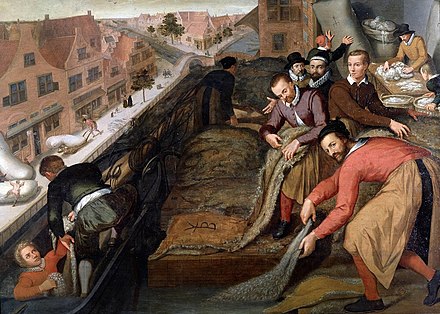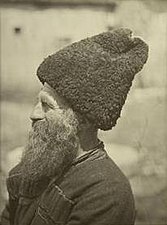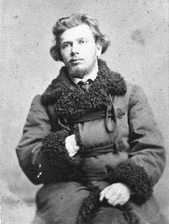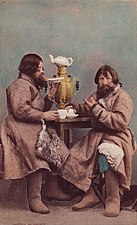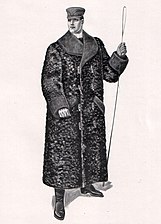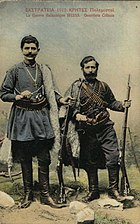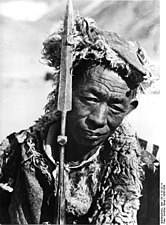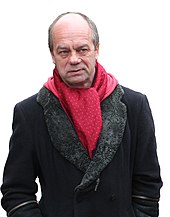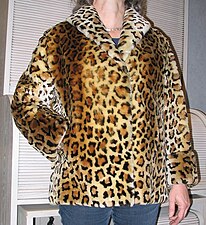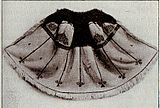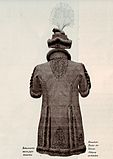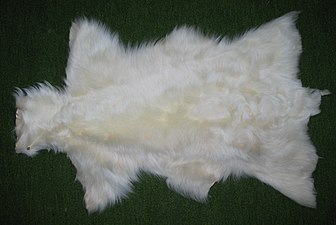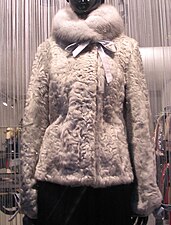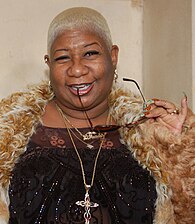Lambskin
Hairy lambskin or sheepskin and the products made from them are sold as commercial goods. For about 10,000 years domestic sheep for lamb , - sheep's milk - and fur kept recovery, so they are probably the oldest breeds. The use of sheep's wool began around 3000 years ago. With millions of pelts produced annually, they are the most important domesticated fur suppliers.
The Food and Agriculture Organization of the United Nations (FAO) estimates the world sheep population at around 1.8 billion. Most skins are not used for fur purposes, but go into the leather industry. The skins of wild sheep are practically not used.
The sheepskin was always above all the warming clothing for the common strata of the population. Even in the early Middle Ages , despite or perhaps because of the great durability of the hair , it was regarded as less valuable fur "only for the lower clergy and the peasant class". In general, the lambskin was particularly widespread among the rural population. There are lambskins of extraordinary diversity and different commercial values. Because of this variety, its sufficient availability , because of the great durability and the various possibilities of fur finishing (scissors, dyeing, printing, velouting , napping ), lambskins are among the most popular types of fur for clothing today .
According to a study published in 2014 on 3000 newborn children, children who slept on animal skin are said to have 80 percent less asthma. The skins were probably the sheepskins usually used almost exclusively for this purpose. These differences were still measurable at the age of ten; at this age it was 41 percent. Based on previous research, this has been attributed to previously unspecified microbes suspected to be in the pelts. The study was carried out by the Helmholtz Zentrum München of the non-profit European Respiratory Society .
General
There are primarily two large groups: the hair sheep and the woolly sheep .
- Hair sheep have a short woolen dress with coarse awning hair. They change their hair in spring and autumn.
- The woolly sheep have a larger proportion of downy hair, there is no seasonal hair change.
A small part of the wool sheep is used for fur production, the so-called fur sheep . Skins of all ages, if they are suitable for fur purposes, are traditionally referred to as lamb in the tobacco industry with almost no exception , especially when they are processed for the end consumer. At times, real lambskins, i.e. the skins of very young sheep, often only a few days or hours old, were actually processed into furs on a much larger scale; the proportion fluctuates depending on the development of fashion. In line with today's demands for comfortable clothing, new finishing methods have made the skins of adult sheep thin, light and supple. Large-area skins of older animals currently make up a higher proportion of the lambskin clothing than it did around 1990.
In the fur of real lambs, the fur trade differentiates between curly, moiré, flamed and straight hair structures, which, however, cannot always be clearly distinguished from one another.
- 1. Curly fur types are Karakul ( Persians ), half-Persians, salt fur, Baghdad (sometimes also referred to as salt fur), Indian and Pakistani lambskins, East Asian, especially Chinese lambskins. The trade describes Italian, Spanish and Greek lambskins as well as Caloyos (Spain, South America) as slightly curled goods.
- Before the First World War , the concept of curly goods was mainly limited to Persians, half-Persians and Saltskins. Since most of it was dyed black, the curly fabric was also called black fabric . At that time, all types of sheep and lambskin were also grouped together as sheep stuff .
- 2. Moiré skins actually also belong to curly goods, but the trade usually regards them as a special type. They have a flat pattern similar to the broad-tailed fur of the Russian karaku lamb. These are East Asian, Indian and Pakistani moirés, Chinese broadtail, chekiangs and others. The term does not apply to the actual broad-tailed skins; also not on broad-tailed buenos and embros, in which the pattern was created by deep-cutting the Lincoln Schmaschen (Bueno) and the Roman lambskins (Embros).
Not only sheepskins are called moirés, but also the best skins of the goat lambs, such as moirierte Kid from China, Asmara kid from Abyssinia and Hodeida from Yemen .
- 3. Hochschur lambskins and sheepskins of various types of lamb and sheep are made usable for fur purposes by shearing and subsequent dyeing. The larger-area hides are partly pre-sheared in their raw state to make it easier to trim the long-haired and partly shaggy skins. Often this was already done in the country of origin with hand clippers in order to reduce transport costs. The finisher will decide later, after a possibly further preliminary cutting, at which cutting height the best drawing can be expected; A hair length difference of just 0.2 millimeters can make a significant difference. The fine-wool, thick-haired, light-leather, merino-like varieties are particularly suitable for Hochschuren.
- 4. Deep-sheared lambskins have a relief-like pattern (moiré) a few millimeters above the leather, which only becomes visible after shearing. However, by screening the raw skins, it is possible to determine which skins are sufficiently marked for deep clipping. Roman lambskins are suitable for this, Lincoln or Montevideo Schmaschen (coat name Bueno -Lamm, earlier also occasionally American-Broadtail (American broadtail), more fully grown skins were still on the market at least before 2000 as Borrego and Borrequito ) are particularly beautiful . The skins that are perceived to be the most beautiful have a peacock-eye-like pattern after deep shearing. Montriesen. referred to a sheared lamb, similar to Buenos, Lincoln or Embros, but of a different origin; they made fur coats of a heavier kind.
- After the Second World War , there was a change to the fact that Lincoln skins were no longer exclusively sheared deep for stocking purposes, in order to give them a Persian-like appearance with a half-high shear.
- 5. Upper hair lambskins are more awny or more woolly, the more awning being the more valuable. As far as the hair is curled, it is tightened by ironing and fixing. They are well suited for precious fur -imitations as marten, sable, polecat , lynx , blue or silver fox and raccoon fur , especially the so-called Tuscan lambskin and Spanish product and its silky quality. Tuscany lamb is a specific type of Italian lambskin, the skins do not have to come from Tuscany .
Most raw hides are delivered cut open, with the head, claws (legs) without hooves and the tail. Individual origins of small lambskins, including those from southern France, Corsica and Sardinia, are sometimes pulled off round; they are mostly traded by weight.
| Designations according to the time of slaughter or death | |
|---|---|
| Skins from premature and stillborn babies | |
| from the unpatterned Karaku lamb | Galjak |
| from the patterned Karaku lamb | Broadtail |
| from other fur lambs | Galjak |
| of woolly sheep | Feast |
| Hide lambs that are one to a few days old | |
| from the Karakullamm | Karakul or Persian |
| from other lambs | Lambskin, e.g. B. Baghdad lambskin |
| of wool sheep, about a day old | Tasty |
| of wool sheep, two to four days old | Research |
| from wool sheep, 3 to 6 days old | Lamb (fur) |
| Skins from animals up to several months old | |
| are referred to as | Lamb (fur), e.g. B. Tibet, Slink, Merino etc. |
| Adult sheep skins | |
| are referred to as | Sheep (fur) |
| The skins of shorn sheep are designated | |
| without wool, only leather goods | nakedness |
| Little wool, for the most part also leather goods |
Sherling or shearling |
| with thicker wool | Grown |
| with a thicker wool dress | Short ones |
| Classification of sheep breeds according to fleece type world population (percentages as of 1956) |
|
|---|---|
| Merino sheep and sheep in merino type | 20% |
| Long wool breeds and long wool crosses | 20% |
| Short wool breeds and short wool crosses | 4% |
| Coarse wool breeds (carpet wool) | 50% |
| Hair sheep | 6% |
The terms research, nakedness, shearling, grown and short-wool are only used in tobacco shops.
Sheep skin is more spongy in summer than in winter and therefore results in less valuable leather. The texture of the skin and wool changes with age. The differences generally only become more apparent with increasing age. The age of the sheep is seen as an important factor in the literature, especially when it comes to changes in wool fineness. The lambswool is finer than the sheep's wool.
The wool is usually finest on the shoulder. This is followed by the stomach and back, while the wool on the legs is almost always the coarsest. The most valuable part of the sheepskin is the centerpiece (croupon), where hair growth and skin thickness are strongest and most even. It is about three quarters of the total area of a hide, more with good skins and less with bad ones. The remaining quarter are "derogatory" parts (sets); good skins are only slightly derogatory on the sides.
Another important factor in determining the value of a hide is its size. Whereas in the past the area was determined with the planimeter , today this is done industrially with the area measuring machine. The information on the back of the fur is either in square centimeters or in square feet, whereby 1 square foot is calculated as 9.3 square centimeters.
- Sheepskin in the national costumes
Dalarne , Netherlands, Girl with a Short Jacket (1843–1876)
Durability
The comparative values ( coefficients ) given below are the result of comparative testing of all important types of fur, i.e. not just sheep and lambskins, by furriers and tobacco merchants with regard to the degree of apparent wear and tear. The figures are ambiguous; in addition to the subjective observations of shelf life in practice, there are also influences from tanning and finishing as well as numerous other factors in each individual case. More precise information could only be determined on a scientific basis. The division was made in steps of ten percent each. The most durable types of fur according to practical experience were set to 100 percent.
-
Durability coefficient :
- Buenos and Embros (sheared lambskins) 50 to 60%
- Caloyos 60 to 70%
- Lambskins (upper hair) 40 to 50%
- Moirés: Eastern China, Indian, Baghdad and Astrakhan 40 to 50%
- Sheepskin (upper hair) 70 to 80%
- Schmaschen 50 to 60%
- Tibet 40 to 50%
history
In 1604 a saw arbitrariness of Wroclaw furrier before that fur lining must be manufactured to specific dimensions. A fox feed required a width of 5/4 and a length of 2 cubits, while the Schmaschen feed was 4 cubits wide and 2 cubits long. In order to check the dimensions of the fodder brought to Wrocław by small-town masters, the Wrocław furrier, to whom such "Schmoschenware" was offered for sale by a foreign craftsman, had to keep it with him and report it to the head elder; only after they were found to be useful (useful) could they then acquire them for processing.
Around 1900 the "discovery" of the Bueno broadtail took place , the realization that certain South American fur races were given an interesting, broadtail-like appearance by shearing. The furs brought onto the market by the tobacco goods refiner A. Herzog from Markranstädt near Leipzig were initially rejected with derision by the trade. The shearing was initially done by family members with scissors, sometimes also by the neighboring hairdresser. This novelty only found recognition much later.
After the Second World War , the processing of sheepskins and lambskins for modern clothing intensified due to the development of synthetic detergents, since the hides were not sufficiently clean industrially with the previous soaps. In many cases, the modern, mostly machine hair finishing had made sheepskins usable for fur finishing .
Curly lamb
Archaeological finds of fragments of clay friezes from 1939/40 in Uruk , in Mesopotamia on the lower reaches of the Euphrates , are the first evidence that there were curly lambs around 2650 BC. From around 600 years later there are illustrations of rulers' headgear that show stylized curls. Around 1400 BC A relief of a Hittite king was created in Sendschirli , Asia Minor, with curls attached to the cap and hem of his coat. Another archaeological knowledge of curly lambs comes from Persepolis (southern Persia). In the Apadana of the palace of Darius I , begun by Darius II (522–586) and finished by Xerxes I , tribute processions , probably from Cilicia , among others , can be seen. Among other things, they bring prepared animal skins (lambskins), woolen scarves and goats of fat-tailed sheep, a breed whose lambs are curled and look very similar to today's Karakul sheep. The only figure adorned with fur was found in Persopolis, the clay sculpture of an unknown Persian head.
The Arab geographer Ibn Hauqal wrote about today's home of the Karakul sheep in 978 that, in addition to red and black fur, lambs were traded for which two to three dinars (around 20–30 gold marks) were paid for their cleanliness and beauty.
Trade in lambskins around 1800

Paul Schöps described the lambskin trade based on an Erfurt manual for goods knowledge from 1801.
According to origin, called "division" in the manual, there are at the time:
- 1. Russian lambskins , black, white
- 2. Circassian , black
- 3. Kyrgyz (not explained; Kyrgyz?)
- 4. Ukrainians , black. You have the most beautiful black. Formerly as Baranken or Parangen in trade.
- 5. Kalmuck , white, colored, brown, red
- "The wool is rough, hairy and not very shiny."
- 6. Bukharian , black, gray
- "Hair curled. The stronger and more even the curl, the higher it is valued. - Later as a Persian in trade. "
- 7. Persian , gray
- 8. Tauric , black, gray, reddish, white
- 9. Icelandic - Danish , white
About the dressing of the furs, the tanning , it only says:
- “First the skins are washed in pure water. Then they come to the Kleyen . The skins are then washed again, this time in salt water or lye . This makes the skins soft and supple. Bad smell is taken from them. The hair gets a nice shine. "
You can learn a lot more about the lambskin trade around 1800:
There are already prepared dishes from Poland, Lithuania and Russia. They are traded in doses or sacks. The counting measure Decher used in the fur and leather trade at the time was ten pieces.
Significant quantities are traded via Samara in winter . Casino Finnish Tatars deliver to here Lambskins that of the Yaik resident Tatars , Kirghiz and Kalmyks come. After the Tatars have sorted the skins, they are trimmed by the Christian Kalmyks who come to the city for this purpose. They also use it to make the furs, including fur sleeping skirts, the tulips. The fur parts are then sold by Tatars to Moscow and other places.
Tatar hats are trimmed with Taurian lambskins. Part of the amount is consumed in the country itself, with pelts worth 250,000 to 300,000 piasters being exported. The main customers are Russia, Poland, Constantinople , Moldova , Wallachia and Romelia , Natolia (= Turkey without Thrace ) and all countries in Europe and Asia. The skins are made into Tatar hats there (the Tatar hat, usually tapering to a point or bent over, has been in use since the 16th century. It is also known as Albanian and Hungarian hat).
The finer lambskins traded in Russia come to the markets via Samara. Kalmuck women sew the paws (claws) into "straps" (as is usual with the processing of leftovers, into strips), from which fur clothing is then made.
After Orenburg come through the Kyrgyz bartering large amounts of skins, some of unborn lambs. It was said of the Kyrgyz skins that they were often more beautiful than the deliveries of the Kalmyks.
In Tauria, people dress mainly in the skins of adult sheep. They are already prepared and mostly processed into fur. These are called Godjuck or Postaki (in Ochakiv and other places on the Black Sea).
Ash gray lambskins are in greatest demand around 1800. They are divided into two types, one of which is called Baklotui , it has short hair and is atlas-like, silky fine. The second variety has longer, curly hairs.
The most important trading center for these goods is Ghöslew . The skins are bought raw and given straight to the dressing, the most beautiful ones go to Poland. Traders from the Crimea bring their skins to the markets and fairs in Mohilev .
In 1762 it said elsewhere: “The blue lambskins are mostly obtained from Kremnitz or Poland. One beats all kinds of furs with it, e.g. E. the Polish and Hungarian out; and caps and sleeves are made of them. White lambskins or Schmaßen come from Iceland, Denmark, or to name the next place from Berlin, from Beeskov . One likes to use them for lining. "
Around 1840, people began to produce “really good” lambskin carpets with flower-like fur mosaics by converting the skin of one color into that of the other color, and vice versa.
| Prices around 1800 | Tulupe = fur dressing gown |
ruble | ruble | ruble | ||||||
|---|---|---|---|---|---|---|---|---|---|---|
| a) Orenburg | Kalmyk lambskins | Bucharian lambskins | ||||||||
| Best cash | 1 tulupe | 20-23 | black | black | ||||||
| b) St. Petersburg | finest variety | 1 tulupe | 50 | lowest variety | 1 tulupe | 50 | ||||
| Russian lambskins | lowest variety | 1 tulupe | 20th | Gray | ||||||
| black | 100 pieces | 10 | White | finest variety | 1 piece | 5 | ||||
| lowest variety | 1 tulupe | 7th | finest variety | 1 tulupe | 40 | lowest variety | 1 piece | 3 | ||
| White | lowest variety | 1 tulupe | 10 | Persian lambskins | ||||||
| best variety | 1 tulupe | 5 | brown | finest variety | 1 piece | 2 | ||||
| lowest variety | 1 tulupe | 3 | finest variety | 1 tulupe | 12 | lowest variety | 1 piece | 1 ½ | ||
| best variety | 1 large sack | 3 ½ | lowest variety | 1 tulupe | 6th | c) Zuruchaitu | ||||
| lowest variety | 1 large sack | 2 ½ | Bucharian lambskins | black lambskins | 1 piece | ½ | ||||
| Circassian lambskins | black | d) Tauria | ||||||||
| black | 1 tulupe | 16 | finest variety | 1 piece | 5 | 1 Godjuck | 30 para to 2 piasters | |||
| finest variety | 1 tulupe | 16 | lowest variety | 1 piece | 3 | Lambskins, gray | 1 fur | 10-15 piasters | ||
| lowest variety | 1 tulupe | 10 | finest variety | 1 tulupe | 150 |
Military sheepskin clothing
In the military, clothing made of lambskin played a significant role in the appropriate climatic conditions, except for headwear, which is usually worn with the hair facing inwards because of the better warming effect.
Ear flap caps in the style of the Russian ushanka were often recently used for headgear , not only in the German-speaking area mostly called Schapka, Russian "cap". The shape of the Russian lambskin hats was also adopted by other countries, which designed their uniforms based on the Russian model. In the Russian army, too, the flat lambskin hat only became common practice in the second half of the 19th century. In 1882 there was the line infantry to parade uniform black lamb caps, as well as the Dragoons , the artillery and the entire general staff . The tsar's generals and wing adjutants wear them made of white lambskin. In the Soviet Army, the lamb hat was limited to the Cossack regiments, where it was already part of the national costume. As early as the 18th century, the Cossacks wore high, cylindrical hats made of gray lambskin with colored cloth bags or high cloth hats with fur brims. In the course of time the shape changed again and again, but it was never completely replaced by the flat cap made of fabric.
According to the Russian model, Serbia and Bulgaria also equipped their troops. Towards the end of the 19th century in Bulgaria the parade uniform included a black or white lambskin hat, in Bulgaria for the princely bodyguard, in Serbia for the generals. For the Turkish artillery and cavalry around the same time, a tall, black, gray lambskin hat with a cloth mirror for the badge of rank, which was about the size of the local Fez , was introduced during and initially after the First World War .
- Sheepskin as military clothing
Description of the lambskin types according to trade terms
Below is the description of the lamb and sheepskin varieties under their trade terms.
- Velor (or nappalan) lambskins or sheepskins are a special type of finishing, only a small percentage of undamaged skins are suitable for processing with the finished meat side facing out. The hair quality plays a subordinate role for the suitability. For velor lamb, the leather side, which is usually colored, is sanded like a velvet and impregnated to prevent water absorption. In contrast to nappa leather, in which the former hair side is coated, the color is applied to the flesh side of the velor lambskin in any subsequent nappa leather-like nappa leather finish. The coating can be colorless or in a color that may differ from that of the hair.
- Beaver lamb , also Mouton doré ( Mouton d'Oré )
Since the finishing type is almost exclusively used for velor and nappa finishing, both terms have declined in linguistic usage. Apparently the product is mostly only offered as merino lamb . For this type of finishing, the wool fineness must be at least 58 °. Beaver lambskins are sheepskins shorn to a hair length of 12 to 16 mm, in which the natural frizz has been permanently removed by ironing and fixing several times, so that even snow and rain do not cause frizz back.
Liftschütz & Zickerow was the first to come up with the idea of ironing lambskins. She is therefore considered to be the initiator of the beaver imitation, known as "Mouton d'Oré". Even though the article was further developed in terms of finishing technology, the main problem remained unsolved for a long time, that the fur unfortunately lost its shine in the rain and became curly again. The Hungarian Fogl happened to become acquainted with a fur refiner who described the problem to him. He then developed a remedy that eliminated all difficulties. The remedy smelled unpleasant and pungent, but was received with great interest by all refiners to whom it was offered. But nobody wanted to buy it from him, every company hoped to figure out the secret on its own. But without success, ultimately the recipe for the so-called fixation process was acquired by the Budapest company Pannonia before the Second World War. There were subsequently a large number of imitations, for which the Hungarian company conducted many patent protection proceedings. The finishing process, which is expensive compared to the fur value because it is complex, is still used today, but has been continuously improved since then.
The use of lamb and sheep skins takes place overall clothing of any kind, of sheepskins addition to (car) seat covers, carpets and other things.
Shorn sheepskins are used in the treatment of bedsores against bedsores . They have a pressure-relieving effect, reduce shear forces and have very good moisture management properties, which can prevent skin maceration. Clinical studies are expected to show a reduction in pressure ulcer cases when sheepskins are used in accordance with Australian Standard 4480-1.1998. Since these skins can be washed at up to 95 ° C, hygiene is no longer a problem.
- Shorn lamb and sheepskin
Indian lamb and Pakistani lamb
In the fur industry, Indian lamb is the skins of young lambs of a fat sheep species from the former north-western India; since the founding of the Republic of Pakistan, this has continued to include skins from northern Pakistan in industry jargon. In the tobacco wholesale trade, the differentiating terms Indian (Delhi) lamb and Pakistani (Multan) lambskins are now exclusively used.
Karakul or Persian
→ Additional articles: Karakul sheep and Persians
The karakul skin or Persian skin is the skin of the lamb of the karakul sheep. It differs from other lambskins by its particularly curly or moiré hair.
Broadtail, Persian broadtail
Broadtail skins without additional designation of origin come from prematurely born, abnormally carried Karakullammers of Russian or Afghan origin.
Merino lamb and Schmaschen
The skins of the young sheep are in the trade under the most varied of names, this chapter deals with the skins of the so-called wool sheep breeds.
- A: Schmaschen
- Sheepskin Schmaschen. Historical working sketches.
Schmaschen (formerly also Schmosen) are the skins of one to two days old, also prematurely or stillborn lambs. They are small to medium in size; the hairiness varies depending on the breed, but mostly short and flat, curly and thin. The skins of a few days old animals have a drawing similar to the Caloyos , they are called researcher. designated.
- Mainly the skins come from South America .
-
- The skins used for deep shearing have a coat length of about 40 to 60 cm, the white hair has a button-like curl. At the base of the hair they have a special moiré that is reminiscent of the drawing of particularly pronounced broad-tailed skins or Swakara Persians. By shearing it deeply, this attractive hair appearance comes to light.
- In the trade they were under names such as Bueno or Bueno-Aires-Breitschwanz-Schmaschen , well-marked as American Breitschwanz or Bueno-Breitschwanz , today mostly simply traded as Bueno or Bueno-Lamm . Even deeper sheared skins of older animals are called Borrequito (Medianito), those of even older animals as Borrego (Mediano). Under the factory expression Tuky- (Tucky) -Breitschwanz ( sp . Taki), wide-tail imitations with a somewhat broad-striped grain came on the market. Alexander Tuma: Pelz-Lexikon. Fur and Rough Goods, Volume XXI . Alexander Tuma, Vienna 1951, p. 217, keyword "Tuky-Breitschwanz" . The more fully grown the fur, the thicker the leather and the more blurred the drawing.
- Argentina delivers large quantities . The very sharply curled, broadly drawn, coarse-haired lambskins are traded as Lincoln Schmaschen . Starting around the 1930s, they were an important trade item, with sales particularly in Europe and America.
- Borregos , in Argentina Borregos-Lincoln after the breed of sheep. Borregos-Finos are called fine-woolen skins that can be used for beaver lamb, vest lining and other things. Around 1969, around 200 to 240 thousand pieces were produced annually in the months of November / December, roughly the same amount as the later fall in late January and early February. The fur size of the six to nine month old lambs is predominantly 5 to 7 square feet. According to a specialist dealer for South American raw hides at the time, only healthy hides of the best meat quality deliver the moiré, silky skin that is light in the leather . “Campos” skins come from land slaughter and are often not treated as carefully, stretched or frame-dried as those from the large slaughterhouses, the Fricaderos, you can see them hanging
- Criollos were called Lincoln skins of Creole breeders, which were considered to be of lower quality and of which only the best qualities were exported, which were nevertheless only suitable for second-class glove leather.
- Córdoba smacks are more goat-like and coarse in the hair and are mainlyprocessedinto fur linings .
- Skins from Uruguay are sold as Montevideo feasts . They are very fine wool; drawn more precisely than the Montevideo Schmaschen; the leather is thinner than in other origins. Less thin-leather varieties can be elicited, they were colored brown and were then on the market as Nutriette Schmaschen . They are used as lining for fabric coats, gloves and other items of clothing.
- Of these, too, the best varieties were called Bueno Breitschwanz
- This is where fine silky smacks come from, especially those from Peru are well suited for coats because of their flaming character, but only small quantities are sold (1988).
- After the deliveries from Spain stopped, only Peruvian Caloyos were left in stores (1988). Spanish Caloyos are about ten percent larger in the body, stronger in the leather and have a stronger undercoat. The hair length of a typical Caloyo is about ten millimeters. According to a leading Caloyo dealer at the time, the weight of Spanish goods should not exceed 11.5 kg per 100 skins, while that of South American skins should not exceed 6.2 kg. According to him, the profitability of a single manipulation process for this article begins at 20 thousand pieces because of the differentiation in the structure and color of the skins.
- Europe
- Smaller skins with thinner leather came from Spain , and in 1988 it was said that the deliveries had now almost completely stopped.
- Around 1900, Schmaschen were often made into foot and hand warmers of all kinds , in addition to lining . A variety that came only from Spain was also black. These were sold under the name of Spanish socks or Bearner socks .
- Tigrados , Spanish curly lamb or sheepskin.
- Trade names of other varieties are:
- Calayos (Caloyos) . Some of them are very silky, some are coarse and mostly flamed.
- The smoked varieties with more lambskin character are traded as pellicones . The best come from Aragon and are sold as Aragon calayos .
- Lower grades also come from Italy and Greece.
- Good, silky, shiny calayos are used for jackets and coats; the fine- wool types, which are thicker in the leather and which are used as inner lining, are traded as merinillas (also the Italian and German Schmaschen).
-
Italy , Sardinia , Corsica
- The quality is very different because of the many breeds of sheep, the number of animals is considerable. Around 1925, around a million of the small, smooth-haired Calabrese came into the trade every year. Use for inner lining, gloves and the like.
-
Belgium , Scotland , Iceland
- The lincoln-like skins are only of limited use due to the numbers painted on with tar paint.
-
Turkey –– Syria
- The often silky and smoky Aleppo stitches are well suited for fur purposes, provided they are not piebald.
Altogether, a distinction is made between tanners = tanner skins (for glove lining and leather production) and furriers = fur skins.
- B: Merinos
are the skins of lambs up to one year old. They do not necessarily have to come from pure-bred Merino sheep, in some cases skins from crossbreeds or from other woolen sheep are also traded under the name.
- The skins from France and Spain are partly silky and good in the leather, partly smooth, sometimes coarser. Lechales are very small skins of Spanish lambs that have not yet grazed.
- Italy distinguishes three main types, the long-haired lambskins ( Italian lamb , upper hair), bastards (crossbred sheep, from cross-bred; merino-like; for shearing purposes or as feed) and merinos (mostly for shearing).
- The best hides are the Tuscans ; the Abruzzo are more woolly; the Romans are moire on fur ground and after shearing as Embros traded ( "where the name originates, we do not know").
- Other trade names are Triestiner (mostly for leather), Abruzzo (woolly, also good long-haired), Manfredonier (very silky, well suited for beavers or nutria imitations ( beaver lamb, nutria lamb )); Sicily , Sardinia (more wavy, sometimes beautiful shine).
- High skins come from the Balkan countries mainly from Bulgaria and Hungary , goods suitable for inner lining from Romania , Bulgaria, Yugoslavia and Greece .
- Transylvanian skinsfrom today's Romania are characterized by theireminent durability. They are made of thick leather and extremely dense and warm wool that is twisted into curls at the tip.
- In 1891 the silky merinos were only in demand for wool production, because they do not represent enough fur, because the fur is completely woolly, awnless and has no character without any drawing . It is precisely these properties that make the material so suitable for velor and nappa lamb clothing today.
- Skins from Northern Europe are sheared, natural or colored.
- In the 1920s it became known in Sweden that the “Gotland free-range sheep” there were well suited for fur purposes. Since the medium gray color was the most popular, breeding shifted from the initially black and white sheep exclusively to this type, only the head and legs are black. Beginning in the 1940s, the type of fur under the name Gotland lamb , later officially called "Swedish fur sheep", also under the fur trade name Viking lamb , as a hard-wearing fur clothing with the hair facing outwards, was very popular for over two decades. For a coat that is 110 centimeters long, about 6 to 6 ½ pelts are required. A decisive economic advantage compared to the significantly smaller skin of younger lambs is that the skin matures at the same time as it is ready for slaughter, at the age of four to five months. The article “ Heidschnucke ” mentions the Gotland fur sheep as a “specialty of the former GDR: Re-breeding of Gotland sheep with Karakul sheep”.
- The Americans refer to the trimmed sheepskins from Central Europe as Alpine Lamb , formerly with the fancy trade name Mandel Lamb .
- In the past, German sheepskins could not be used for Hochschur refinement because of the straw-like hair and the high fat content of the leather. In the post-war period, the refinement of a large part of the resulting goods was also achieved in perfect quality.
- German sheepskin deliveries are accepted by weight. Salted goods are better suited for fur purposes than dried ones. Silky skins are of better quality than woolly ones. Thick-leather goods with a high natural fat content are lower in price. Further reductions in value are color stamps and blood stains, since hair loss often occurs in the latter.
- Wherever sheep are raised, there are lamb and sheepskins. Sometimes they are used as fur, sometimes as leather. They come from a wide variety of races, which are initially kept for wool, meat and milk production.
- From overseas - except South America, see the beginning of the article - come skins that have different trade names, depending on the finishing, from which one cannot easily recognize the origin.
- In the past, large curly skins came from Iceland under the trade name Clondyke , later small curly skins which were mostly processed in the country to make up (as of 1988). Around 1925 they were a popular material for children's jackets and sets (muff, hat, scarf, gloves). At that time, exports seldom exceeded 20 thousand skins.
- Before the First World War, the so-called Angora sheep skins were very popular for bed rugs and fur blankets . They had a wool about 20 cm long, which was mostly dyed in fantasy colors. The skins came from English Lincoln and Leicester sheep. Short Shorn Angoraschafe were called in England Cavalry skins because of valances were used the cavalry.
- Sheep breeds in Germany
Prepared hides are traded by square feet (raw hides mostly, according to weight classes). They are sheared, dyed, printed, refined into velor lamb or napped to make all kinds of clothing.
- Average weight of European sheepskins best suited for fur purposes per 100 pieces (1936):
- Italy:
- Tuscany = 48 to 50 kilograms
- Abruzzo = 70 to 72 kilograms
- Merino bastards = 40 to 45 kilograms
- Bulgaria = 55 to 60 kilograms
- Greece = 55 to 60 kilograms
- Spain:
- Navarre = 45 kilograms
- Catalonia
- First = 65 to 70 kilograms
- Medium = 85 to 90 kilograms
- Second = 100 to 110 kilograms (up to 120 kilograms)
- Romania and Southern Russia
- Southern Russia = 100 to 110 kilograms
- Zigaya sheep, etc. = 100 to 110 kilograms
- North africa
- Early onset = 60 to 75 kilograms
- High season = 100 to 110 kilograms
These weights are to be considered with reservation. Not only did the skins come onto the market with different levels of soiling, they can be shorn at different heights, among other factors. While the skins from Abruzzo were delivered with the head skins, in other traditions they were cut off.
Sheepskin coats (also made goatskin coats), which were worn without a fabric cover in winter with the leather side facing outwards, by the shepherds with the hair facing outwards in summer, were referred to as naked fur or in Hungarian Bunda . A rural children's riddle points to this dual use: “What is it: cool in summer, warm in winter?” In the whole of Southeastern Europe, especially in Hungary and the neighboring countries, they were often richly embroidered and not part of the shepherd's and peasant's dress . The embroidery was part of the work of the local furriers and was done by men working from home. The products of the furriers from Mošovce in Slovakia were particularly valued for their artistic embroidery . The forerunner of the Bunda was the Suba (pronounced: "Schuba"), a sleeveless cape with a simpler cut, but often already provided with artistic embroidery. A more traditional version of the Naked fur was widespread in East German peasantry Zippel fur with its front and rear extended hem (coattails).
The Transylvanian Saxons in what is now Romania wore church fur, a sheepskin coat that reached down to the calves, the edges, sleeves and collar of which were carefully trimmed.
The curly lamb is the skin of young, curly New Zealand lambs where the curl is still closed. They are particularly light.
- Embroidered sheepskin from Eastern Europe

Before he besieged the fortress of Sabác, King Matthias ordered ködmöns, hip-length jackets and fur gloves, from the furriers for 8,000 soldiers. Before the First World War , naked furs were still found in the east of what was then Germany, in Upper Silesia , Posen , etc. During the war, two million furriers were probably made by German furriers for the winter campaign. As a waistcoat, wax fur and later as a flight jacket, they held a special position in both world wars.
In European Russia, there were color preferences that certain classes strictly adhered to. Russian peasants only wore white, Kalmyks only coffee-brown ( Kalmützki Tulubi ), Tatars only silver-gray and Russians only black lambskins (1841).
The papacha is a striking, traditional Caucasian headgear for men, which is usually made of sheepskin or lambskin.
Skins from crosses of Karakul sheep with native sheep are more or less Persian-like, therefore they were traded as Karakul-Metis and Half-Karakul.
The RAL regulations say that furs from the Soviet Union can only be traded as Metispersians , from Afghanistan as Dubar and from Bessarabia only as Bessarabers or Romanian half-Persians .
- Russian Metis-Persians are smaller than the skins of pure-bred Karakul sheep; the more open curl is silky and shiny.
- The Bessarabers or Romanian half-Persians are the finest, Persian-like furs; smaller than the Bukhara Persians. Mostly black, partly gray, brown and piebald. In 1928 a fur trader wrote that the pure Bessarabian half-Persian does not have the so-called “negro curl” of black and gray smacking and is therefore more valuable; it is more like real Buchara fur, even if the curl is less hard. However, the Bessarabian herds were not kept free from the Romanian sheep, so there was a risk that the pelts could lose their value in a few years. Skins of prematurely born or unborn Bessarabian lambs skins were called "Klitschen", in contrast to "broad-tailed" with the Karakul sheep.
The first importation of karakul sheep from the Russian ancestral area in Turkestan to what was then also Russian Bessarabia took place in 1880. In 1884 the first thoroughbred karakul breeds were mentioned in Bessarabia. After the union of Bessarabia with Romania, this breed took a considerable boom. The Karakuls were crossed with the native zackle sheep, the result was the half-Persian.
- The Dubar from the Heradj and Massar breeding areas in Afghanistan are coarser and weaker than the skins of purebred animals.
Other curly furs of fat- tailed sheep or fat-tailed sheep, which according to the RAL regulations are not allowed to bear the designation Persian in any form are:
-
Soviet provenances
- Crimmers from the Crimea (largest, best) and from Ukraine (heavier, longer-haired). The large open and high curl is soft and feathery. Mostly gray, gray-white, more rarely brown; Persian-sized, sometimes larger.
- Ukrainians from the Poltava area are similar to the Krimmer with a more open curl; gray and black. The better curly, gray quality is called Post , the lower, large and soft curly Tesser (Tescher).
- Schmuschka from southern Russia are poodle-like coarse; black and gray; small grain.
- Merluschka from the Kyrgyz steppe, from the Urals to China, have more open curls, are somewhat coarse and curled; partly beautiful in the pattern; brown, partly white, black and piebald.
- Raw hides (crosses with Tatar sheep) were traded in Germany as Treibel (Dreibel), refined hides as Astrachan . See → main article: Astrakhan .
- Oriental lambskins
- In the oriental countries, especially in earlier centuries, sheep were used to a particular extent in wool production for carpet weaving. That is why the annual amount of lambskins depends particularly on the respective market price; if it is too low, the lambs are not slaughtered but raised for meat and wool.
-
-
Iran lambskins have very different types of curls, often they are Persian-like. They are smaller than Persians, and overall silky than Iraqi.
- Shiraz from southwest Iran to the Persian Gulf are very similar to the Persian, but weaker in quality. Overall, they are silky than the Iraqi ones. In 1941, the product ranges generally consisted of 25 percent gray, 10 percent colored and 65 percent black fur.
- Mesheds from northeastern Iran to the border of Turkmenistan have a slightly more open curl and are slightly lower in quality than Shiraz.
- Kum , also older and Chum, after its trading center, the city of Qum Qum named in 1950 as Koompersianer referred. The skins come from north-west central Iran. They produce large, heavier skins with sometimes very good curls, but are less shiny. Some of them have excellent, broad-tailed markings.
- Iraqi and other Asia Minor lambskins
- The qualities are quite different, in the main time of the fashion of curly and moiré furs 60 to 70 thousand furs were in the trade every year.
- Baghdad , the best are the Mosul; large skins with large open curls. Broad-tailed skins are traded as Baghdad moiré. Mostly they are black, also gray, brown or piebald.
- Syrians are mostly divided into Syrian lambskins , the small curly ones also called Baghdad and the lesser skins as salt skins. About 60% of the skins are white.
- Arabs , they are the lowest varieties and are also mostly traded as salt skins.
- Saltskins are the name given to the smaller, curly lambskins, which are generally weaker in quality and even less shiny than Kum. The name "Salzfelle" was formed in the fur trade town of Leipzig at that time, because the skins were preserved with salt in contrast to the shot stain (bran stain). Deliveries come from Iraq, the quality is getting worse towards the Arab border. Color variants are black, brown, gray, white, partly piebald. Premature babies are called takir .
-
Iran lambskins have very different types of curls, often they are Persian-like. They are smaller than Persians, and overall silky than Iraqi.
Processing is the same as for other lambskins.
The number of incidents could not be determined in 1988, due to the war events there were practically no fresh lots on the market.
- Half Persian
- Oriental lamb
Chekiang lamb jacket with blue fox fur collar (2010)
East Asian lamb and sheepskins

Deliveries are mainly made from the eastern and north-eastern parts of China and Mongolia.
China
Mainly the skins of young lambs come from China, moiré or somewhat curled depending on their origin; silky and glossy. Usually as boards already prepared for further processing (mostly approx. 60 x 120 cm).
Chekiang lamb
Chekiang , outdated Chekiang-Karakul, come from Shanghai mouflons. They are white and very rarely spotted; the curl is flamed.
Shantafoo lamb
Shantafoo lamb comes from Hebei (Tschilli), especially from the area north of Tianjin - Beijing - Kalgan . The skins, which are somewhat similar to Astrakhan, are silky and finer than Chekiang lambskins.
Tsining Moiré Lamb
are flat in the hair, sometimes broad-tailed to galjak-like and less silky. The leather is sometimes very thin. Their value is less than shantafoo lambskin (tsining, tsinnin, old names of the administrative area and city of Jining in east China's Shandong Province ).
Peking moire lambskin
is similar to the Tsining Moiré lamb, but has a thicker leather. Because of the stronger, more stable leather, it is better used as tsining moiré.
Tientsin (Tianjin -) - Lamb, Silklamm
- Tientsin-Lamm, Silk Lamm (2016)
Silklamm, moiré lamb, washed lamb, also Chinese broadtail , mainly made from Tientsin ; moiré white or spotted lambskins.
Shantung lamb
Shantung are very flat, moiré, partly broad-tailed or galjak-like (similar to the premature birth of the Karakul sheep), less silky; sometimes very thin leather.
Kalgan lamb
Kalgan , white and spotted.
Sinkiang lamb
Sinkiang , white, brown, black and spotted; but rarely on offer.
Persians
in insignificant quantities, not very beautiful.
Black Chinese Broadtail
The small-area skins from the Hailar district have a broad-tailed moiré, mostly they are sold as bars.
Tibetan lamb
Tibetan lamb, also known as “Tibet” for short, Chinese Tan-Pih (Pih = fur), American also Tibetan, is the fur of the six-week to two-month-old lambs of the young Shanghai mouflon. Contrary to the trade name, it does not come from Tibet, but from northern China. Characteristic of the coat is its corkscrew-like curly structure. The fur length is about 80 to 110 centimeters; the silky hair is white to yellowish.
The fur is used for blankets and clothing purposes, especially for trimmings, smaller fur parts and accessories. Tibet is considered to be extraordinarily subject to fashion.
Slink lambskin and sheepskin
Bast shoes, lined with lambskin (France, World War II )
Boots, so-called Ugg boots , made from Australian lambskin (2011)
The skins come from the provinces of Shanxi, Shaanxi and Hebei (Tschilli). The Chinese name is Tseo-Ko. Slinks are short-haired and have a shiny, white to ivory-colored, finely curled curl (pearl lock).
- A distinction is made between the provinces
- Hsinchecs (Hsinchis), very thick wool with a good undercoat and
- Linchis (Lienshengs), somewhat thinning hair, broad curls and smokers.
These types are wholesaled as tablets, including the skins as well as claw, head, ear, neck and other piece tablets. Around 1930 also partly in the traditional Chinese cross shape. They come from the provinces of Kalgan, Shantung and some southern provinces.
The skins of adult animals were once traded under the name Shanghai mouflon (Mouflon, Tibetine), which is incorrect zoologically for a domestic sheep , and Mongolian and North Chinese goat skins were also incorrectly traded as mouflons . Sheepskins were exported to America in large quantities (until around 1931), in Europe the more open, curly, stringy goods were less in demand, and in general they were at times severely neglected by fashion.
1952 marked a Head Shop Kaufmann as mouflon wild sheep, whose skins from the Altai region came also from the East mongolei and the northern part of Shanxi . The skins came on the market in white, brown, yellowish and bluish and plucked. At that time, however, they had not been on the market for a long time.
A floor cover is a nose protector for horses, usually made of lambskin or similar voluminous material
Slink skins also came on the market around 1930 in a cross shape made up of three skins each. Sheepskin boards have also been available for several decades, white or colored, sheared, combed out and ironed, the hair length is 15 to 20 mm. When the skins were particularly low in price before 1914, they were processed in large quantities into shoe and glove linings, and some were exported to Poland and Galicia for use in lining.
In Leipzig it was very soon possible to refine slinks in beautiful colors (Persian gray, brown and white, as well as plain colors black, brown, dove gray, etc.). After the Second World War, interest in the type of fur decreased extremely sharply, and slink sheepskins were only occasionally used in world trade. These and also slink lambskins were lightly sheared undyed in order to achieve even surfaces. For a time, there were also few goods on the world market because the skins were processed for military winter clothing. Today the sheepskins are used in particular for car seat covers (1988).
The fur remains are processed into
- Chinese lamb leg plates, on the one hand Karakulklauen plates and more rarely, lamb leg plates (before 1958). They arise from the claws (leg skins) of the Shantafoo, Chekiang and Tsining lambskins. The larger the claws, the longer-haired the tablets. The best is a flat, silky and light product that comes from the moirés and therefore has a particularly beautiful pattern. Most of it went to North America, from the beginning of 1939 to 1941 the export to there amounted to 130,000 tablets.
- Chinese lamb platters
- a) Lamb head plates (also front part), Lamb Head Plates
- b) Lamm neck panels , Lamb neck plates
- c) Lamm ears panel , Lamb Ear Plates
These semi-finished products also went mainly to America, from the beginning of 1939 to May 1941 this amounted to 21,000 lamb head bars and 10 thousand pieces of lamb ear bars.
As Jehol lambskin bars are on the market that do not come from sheep but from goats (as recently as the 1980s). These are very curly kid boards. With less pronounced attraction, the products were usually referred to as Chinese Astrakhan, Kid-Astrakhan or Tapanchang (a city in the Jehol province (= Tangshan ?)).
Mongolia
Most of the lambskins from Inner Mongolia are sold as Mongolian lambskins . The curl is similar to astrachan (crimmer-like, curly curl), spiral, but more open; mostly white; small in area. These, too, are mostly available as prefabricated tablets in wholesalers, including names such as Mongolin tablets or Kalgan tablets.
The mostly particularly light East Asian lambskins are processed into jackets, coats, inner linings and blankets. Since they are usually available in white, they are particularly suitable for dyeing in all fashion colors. Sheepskins are also on the market, which are mainly used for car seats.
processing
Velor, nappa lamb and other sheepskin clothing
The skins of adult sheepskins do not make any extraordinary demands on the furrier or leather processor, except that they require particularly clean and careful work. For the padded fur, to be worn with the hair facing outwards, the skins, when they were refined into beaver lamb, were often put together into panels that were easy to process before shearing, that is, the damaged areas of the skins were repaired (" attached ") and the The narrower parts of the head and the hardly hairy areas on the extremities, called Diechen by the furrier, were previously removed and dismantled. The resulting seams were almost invisible due to the shearing and subsequent ironing. Since sheepskin clothing is currently hardly ever lined with the hair facing outwards, this material -saving semi-finished product has not been manufactured since around 1990.
Velouted and napped lambskins can be joined with the single-thread or two-thread fur sewing machine or with the leather quilting machine . The fur sewing machine or similar machines that create an overly sewn seam sew the fur together edge to edge in the manner of a hand seam. This results in a particularly soft drape, the seam is used for particularly casual items of clothing. The seam of the quilting machine, for which a seam allowance is required, is more elegant.
The skins are usually placed on top of and next to each other with simple straight seams. Special decorative seams can be made with special machines. The collar is usually covered with either the same fur or a more noble type of fur. Common closure options for coats and jackets are buttons that are buttoned either in buttonholes, in button strips with buttonholes or in button flaps. Braided trimmings are a special type of closure, especially for traditional and military clothing.
In 1967, the then leading Hungarian producer of velor lamb clothing described the production:
At the end of the 1930s, Hungary developed the modern production of velor lambskins into fur vests, traditional jackets and long fur coats. With the development and introduction of chrome tanning, Hungary became a pioneer in this field. For velor lambskins, skins with less than 30′S wool fineness (Int. Bradford quality number ) with 30–70 mm and a wool length of 30–70 mm and a weight of 60–100 dkg ( Dekagramm ) were processed, the finished areas were between 28 and 35 square decimeters.
The clean wool side with a perfectly white wool surface is achieved with optical bleaching agents. Brush dyeing is used on the leather side.
The size of the velor lambskin is 25 to 40 square decimeters. It is economically important to use the material with minimal waste. The model designer must already consider the most economical division and draw it in the pattern according to the fur size. The difficult thing is that the seams must not be disturbing and adapt to the respective fashionable line. Due to the approx. 30 to 60 cm long skins, the transverse seams are located an average of 10 to 15 cm below the waist height and at the same time serve to accommodate the pocket openings in the front part. Often other types of fur are used for collars and cuffs, such as nutria, beaver, various types of fox, Persian, and recently even mink, long-haired lambskin or lamb in different colors.
Sorting is more time-consuming than with normal fur, the fur should not only harmonize on the hair side, here this is the inside of the item of clothing, but above all the suede outside must have a uniform color.
The hair is shaved off the topstitching seams, especially on the contours of the front parts and the collar, in order to achieve the finest possible edges and seams. When working with the special quilting machine, care must be taken that the edges are not pulled out. Therefore, when sewing, narrow batiste tapes are concealed. After a series of handicrafts such as sewing collars, overcasting, sewing on buttons and the like, the velor fur is processed, dusted, brushed and trained with the hand iron.
In general, those lambskins that are unsuitable for higher quality uses are used for shoe linings.
Curly or moiré lambskins
Much more complex is the production of classic fur coats from the small, curly or moiré skins of young animals such as Persians (Karakullamm), Indian lamb, Baghdad lamb and all others. The sewing is done with the fur sewing machine, invented before 1900, which creates a single-thread overcasting stitch similar to a hand seam .
A sheepskin coat usually requires less than ten skins, while lambskins require twenty, thirty or even more skins. Since they are worn with the hair side out, the sorting requirement is much higher. While the clothing industry often has large lots sorted for clothing production, the furrier receives the skins from the tobacco shop, pre-sorted in so-called furrier bundles or assortments, each sufficient for a jacket or coat.
The lambskins are sorted again by the furrier, tailored to the model. After that, they can be left in their natural shape and put together next to and on top of each other. However, if fashion prefers surfaces that run as smoothly as possible, the skins are cut into one another to form a strip the length of a jacket or coat, which is known as incision. A mirror-like part can be achieved by offsetting, whereby the resulting stripes are split in the middle of the fur, one half of the fur is placed in the right, the other in the left half of the garment. In order to obtain unrecognizable connections between the skins and parts of the skins, the skins are not joined with straight seams, but rather in a serrated or wave shape. In the last few decades, with their rising wages, economic aspects have become more important in the choice of work technique.
Persian is usually processed with the head down ("overturned") in order to achieve a shiny hair appearance. Krimmer and Astrakhan, on the other hand, should be worked with the head up ("in line").
Material consumption for the individual types of lambskin
In 1965, the fur consumption for a fur board sufficient for one coat was given for different types of lambskin (so-called coat "body"):
- Astrakhan (half-Persian) = 30 to 40 skins
- Baghdad moiré = 30 to 45 skins
- Bessarabians = 24 to 30 skins
- Borregos = 6 to 9 skins
- Borrequitos = 10 to 14 skins
- Broadtail and Galjak = 30 to 45 skins
- Buenos (Lincoln deeply sheared) = 24 to 34 skins
- Caloyos = 40 to 50 skins
- Chekiang = 40 to 50 skins
- Chinese broadtail , black = 5 panels of 9 heads
- Cumafix = 14 to 20 skins
- Embrofix = 36 to 40 square feet
- Embros = 14 to 20 skins
- Erofix = 36 to 40 square feet
- Gotland Lamb = 36 to 40 square feet
- Indian lamb = 30 to 40 skins
- Kalgan = 5 panels for one coat
- Krimmer = 24 to 30 heads
- Lincoln = 24 to 34 heads
- Mongolin = 5 tablets for one coat
- Merluschka = 24 to 36 skins
- Meshed = 24 to 30 skins
- Mongolin = 5 tablets for one coat
- Oriental lambskins ; Salt skins (Baghdad-Mosul smaller; Baghdad-Syrians mostly smaller; Arabs smallest) = 33 to 40 skins
-
Persians:
- Buckars = 24 to 26 heads
- Turkmen = 24 to 26 skins
- Kazakhstan = 24 to 26 skins
- Afghans (largest variety) = 22 skins
- Africans = 24 to 26 skins
- Shiraz = 24 to 30 skins
- Schmaschen = 40 to 50 heads
- Schmuschka = 24 to 30 skins
- Shantafoo = 40 to 50 skins
- Swedish lamb = 36 to 40 square feet
- Slink = 6 to 8 heads
- Sydneylamm = 36 to 40 square feet
- Toskanamm = 12 to 16 skins
- Tsining Moiré = 40 to 50 heads
- Mouflon = 14 skins
- Nevada Dam = 36 to 40 square feet
A board with a length of 112 centimeters and an average width of 150 centimeters and an additional sleeve section was used as the basis. This corresponds roughly to a fur material for a slightly exhibited coat of clothing size 46 from 2014. The maximum and minimum fur numbers can result from the different sizes of the sexes of the animals, the age groups and their origin. Depending on the type of fur, the three factors have different effects.
Web links
Individual evidence
- ↑ Rolf Minhorst: What exactly is a hair sheep? Osnabrück April 2008.
- ↑ a b c d e f g h i j Christian Franke, Johanna Kroll: Jury Fränkel ’s Rauchwaren-Handbuch 1988/89. 10th, revised and supplemented new edition. Rifra-Verlag, Murrhardt, pp. 262-301.
- ↑ Fritz Schmidt : The book of the fur animals and fur. FC Mayer Verlag, Munich 1970, pp. 350-369.
- ↑ www.scinexx.de/wissen-aktuell , European Lung Foundation, September 8, 2014.
- ↑ a b c d e Paul Schöps: lambskins and sheepskins. In: The fur trade. 1957, No. 4, Volume VIII / New Series. Hermelin-Verlag, Leipzig / Berlin / Frankfurt am Main 1957, pp. 129–135.
- ↑ a b Herbert Müller: Lincoln ..., their origin, their refinement, their beauty 2nd episode. In: All about fur. No. 1, January 1965, pp. 27-29.
- ^ Friedrich Jäkel: The Brühl from 1900 to World War II. , 5th continuation. In: All about fur. August 1966, p. 83.
- ↑ Alexander Tuma: Pelz-Lexikon. Fur and rough goods. XX. Volume, Verlag Alexander Tuma, Vienna 1950. Keyword “Montriesen”.
- ↑ H. Grell: Studies on sheep and goat husbandry in the tropics and subtropics (Part II.). Ifo Institute for Economic Research, Weltforum Verlag, Munich 1973, p. 43. According to Carter and Chalet (1956, quoted in Schäfer: Direction of use of the sheep breeds under the influence of the location. In: Handbuch der Tierzüchtung. Volume 3, 2nd half volume, publisher Paul Parey, Hamburg / Berlin 1961, pp. 164-180).
- ↑ Darioush Mehdi, p. 4. After White and Caughley (quoted by Küntzel): A. Küntzel: Handbuch der Gerbereichemie und Lederfabrikation . Springer Verlag, Vienna 1944.
- ↑ Dariousch Mehdi, pp. 4-5. After Frölich, Spöttel and Dancer and after Doehner: C. Frölich, W. Spöttel, E. Dancer: Die Wollkunde . Springer Verlag, Berlin 1929. - H. Doehner: Handbook of sheep breeding and keeping . Volume 4: The Performance of the Sheep . Paul Parey publishing house, Berlin and Hamburg 1954.
- ↑ a b c d Dariousch Mehdi: Subjective and objective criteria for the quality and type of use of lambskins and investigation of the lambskin qualities in different types of crosses for lamb production. Dissertation University of Hohenheim, 1972, pp. 2, 4, 38, 45, 62. → Table of contents .
- ↑ Paul Schöps; H. Brauckhoff, Stuttgart; K. Häse, Leipzig, Richard König , Frankfurt am Main; W. Straube-Daiber, Stuttgart: The durability coefficients of fur skins. In: The fur trade. Volume XV / New Series, No. 2, Hermelin Verlag Dr. Paul Schöps, Berlin / Frankfurt am Main / Leipzig / Vienna 1964, pp. 56–58.
- ^ Fritz Wiggert: Origin and development of the old Silesian furrier trade with special consideration of the furrier guilds in Breslau and Neumarkt. Breslauer Kürschnerinnung (Ed.), 1926, p. 112. → Table of contents .
- ↑ Editor: On the history of tobacco dyeing. I. From the beginnings of black dyeing. In: Der Rauchwarenveredler No. 18, supplement from Der Rauchwarenmarkt. No. 19, Leipzig, March 9, 1935.
- ↑ A. Noldeke include: Ninth preliminary report on the ... in Uruk Warka undertaken excavations . Verlag der Akademie der Wissenschaften, Berlin 1938, p. 7, 22. From Wolf-Eberhard Trauer: 4600 years of curling lambs breeding . In: Brühl. November / December 1967, Fachbuchverlag Leipzig, pp. 11–12.
- ↑ Erich F. Schmidt: Persepolis I Volume 68. Orient Institute de University of Chicago, 1958, pp. 68, 87, 118. From Wolf-Eberhard Trauer: 4600 years of curling lambs breeding . In: Brühl. November / December 1967, Fachbuchverlag Leipzig, pp. 11–12.
- ↑ Ibn Haukal, Abul Kasim: vise et regna (Arabic). Bibliotheka geographorum Arabicorum 1873, p. 106. From Wolf-Eberhard Trauer: 4600 years of curling lambs breeding . In: Brühl. November / December 1967, Fachbuchverlag Leipzig, pp. 11–12.
- ↑ a b Paul Schöps: Trade in lambskins around 1800. In: Das Pelzgewerbe Jg. XVII / New Series 1967 No. 1, Hermelin-Verlag Dr. Paul Schöps, Berlin et al., Pp. 24-29. Primary source: Untitled “Handbook of goods science with detailed chapters on smoking goods”, Erfurt 1801 (probably D. Johann Krünitz: Economic-Technological Encyclopedia ).
- ↑ The Kirschner. In: JS Halle: workshops for today's arts. Berlin 1762, see p. 312 .
- ^ D. Johann Heinrich Moritz Poppe: Johann Christian Schedels new and complete wares lexicon. Second part M to Z, fourth thoroughly improved edition. Verlag Carl Ludwig Brede, Offenbach am Mayn 1814, p. 214, keyword “Postaki”.
- ↑ Note: There are three cities with the name Mohilew in southwestern Russia. One is on the Djnepr, the other on the Dniester in Podolia and the third, insignificant, on a tributary of the Djnepr in Ukraine. Schöps suspects that it is the governorate capital Mohilew on Djnepr, near which is Sklow, a former fur market, which had trade connections with Leipzig.
- ↑ The Kirschner. In: JS Halle: workshops for today's arts. Berlin 1762, see p. 313 .
- ^ Christian Heinrich Schmidt: The furrier art. Verlag BF Voigt, Weimar 1844, pp. 174-175.
- ↑ Note .: Zurucha: Zujewsk, Trans-Baikal, southeast of Nerchinsk .
- ↑ a b Eva Nienholdt: Fur in the war costume and uniform. In: The fur trade. Volume IX / New Series, 1958 No. 6, Hermelin-Verlag Dr. Paul Schöps, Berlin et al., Pp. 271-276.
- ↑ P. Spahl: Beaver lamb and its refinement. In: The fur industry. Issue 2, Berlin, February 1964, pp. 26-29.
- ^ Editing, according to information from Günter Laforce, company GEFU: specialists for raw Borregos. In: The fur industry. March 1965, pp. 102-106.
- ↑ Argentine Lincoln Schmaschen. In: Deutsche Kürschner-Zeitung. Edition A, No. 10, Verlag Arthur Heber & Co, Berlin April 5, 1934, p. 290.
- ↑ Claus Debusmann: Thoughts on Caloyos. In: Pelz International. 1972, p. 41.
- ↑ a b c d Paul Cubaeus, "practical furrier in Frankfurt am Main": The whole of furring. Thorough textbook with everything you need to know about merchandise, finishing, dyeing and processing of fur skins. A. Hartleben's Verlag, Vienna, Pest, Leipzig 1911, pp. 61-67.
- ↑ a b c Emil Brass : From the realm of fur. Second improved edition. Publishing house of the "Neue Pelzwaren-Zeitung and Kürschner-Zeitung", Berlin 1925, pp. 821–834.
- ^ Philipp Manes : The German fur industry and its associations 1900-1940, attempt at a story . Berlin 1941 Volume 2. Copy of the original manuscript, p. 8 ( G. & C. Franke collection ).
- ↑ B. Gahne, Ö. Danell, T. Sjögren: Properties of the fur and breeding of the Gotland sheep (lecture from the 3rd International Karakul Symposium Samarkand / USSR 1975). In Brühl November / December 1976, VEB Fachbuchverlag Leipzig, pp. 13-14.
- ↑ G. Buschmann: Gotland lamb - an interesting fur. In: Brühl. May / June 1978, VEB Fachbuchverlag Leipzig, pp. 8–9.
- ↑ without mentioning the author: Interesting facts about Viking lamb. In: "Die Pelzwirtschaft" 11-12 (1985), CB-Verlag Carl Boldt, Berlin, p. 39.
- ↑ Dictionary of Furs .
- ^ A b c Max Bachrach: Fur. A Practical Treatise. Prentice-Hall, Inc., New York 1936, pp. 464-499 (English).
- ^ Siegfried Beyer, Naunhof-Leipzig: For the assessment of fur skins. In: The fur trade. 1951 Issue 1, Hermelin Verlag Paul Schöps, Berlin / Leipzig, p. 3.
- ↑ Signed Dr. IE: Hungarian peasant fur . In Der Rauchwarenmarkt Nr. 3/4, January 16, 1942, Hermelin Verlag Dr. Paul Schöps, Berlin / Leipzig, p. 4.
- ^ Francis Weiss: From Adam to Madam . From the original manuscript part 2 (of 2), (approx. 1980 / 1990s), in the manuscript p. 260 (English).
- ↑ Eva Nienholdt: Men's furs in folk costumes. In: The fur trade. Vol. XVII / new series 1966 No. 3, Hermelin-Verlag Dr. Paul Schöps, Berlin et al., P. 131.
- ^ Mária Kresz: Popular Hungarian furrier work. Budapest 1979, ISBN 963-13-0419-1 I.
- ↑ Alexander Tuma: Pelzlexikon XX. Tape. Alexander Tuma Verlag, Vienna 1950, keyword “Nacktfurze”.
- ^ FA Brockhaus : General Encyclopedia of Sciences and Arts. Published by JS Ed and IG Gruber, Leipzig 1841. Third Section OZ, keyword “Fur”.
- ^ Moritz Kassner: The raw materials business in Bessarabia. In: Der Rauchwarenmarkt No. 63, Leipzig, May 26, 1928.
- ↑ No author's name: Romania's fur industry. In: The fur trade. No. 65, Leipzig, June 2, 1931, p. 4.
- ^ Bar .: The Karakul breed in Romania. In: The tobacco market. No. 27, Leipzig, July 5, 1940, p. 27. Primary source: A document from the Association of Karakul Sheep Breeders of Romania in Bucharest.
- ↑ a b Max Weck, according to information from the German-Iranian Chamber of Commerce: The fur trade in Iran. In: German Kürschner magazine. 38th vol. 19, Verlag Arthur Heber & Co, owner Carl Boldt, Berlin July 5, 1941, p. 336.
- ↑ Alexander Tuma: Pelz-Lexikon. Fur and Rough Goods, Volume XIX . Alexander Tuma, Vienna 1950, p. 63, keyword “Koompersianer” .
- ↑ a b c d Aladar Kölner (tobacco shop): Chinese, Manchurian and Japanese fur skins. In: Rauchwarenkunde - Eleven lectures from the goods science of the fur trade. Verlag Der Rauchwarenmarkt, Leipzig 1931, pp. 91-104.
- ↑ a b Alexander Tuma: Pelz-Lexikon. Fur and rough goods. XXI. Tape. Verlag Alexander Tuma, Vienna 1951. Keywords “Tescan beaver lamb”, “Tsinnin broad tail”, “Tsinnin lambskin”, “Tuky broad tail”.
- ↑ a b c d e f Paul Schöps: East Asian lambskins and sheepskins. In: The fur trade. No. 1, Volume IX / New Series, Hermelin-Verlag Leipzig, Berlin, Frankfurt am Main 1958, pp. 9-14.
- ↑ Richard König: An interesting lecture (report on the trade in Chinese, Mongolian, Manchurian and Japanese tobacco products). In: The fur industry. No. 47, 1952, p. 50.
- ^ Franz Rudolf Märkle: Memories from my 50 years of activity in the tobacco shop . Self-published, Fürth 1960, pp. 30–32.
- ↑ Woven fur clothing : In Die Haspel , Rifra-Verlag Murrhardt, born 1962, p. 8.
- ↑ G. Rimar: Design and manufacture of velor fur coats from velor lambskins. In: The fur trade. Vol. XVIII / New Series 1967 No. 1, pp. 32–33.
- ↑ Paul Larisch, Josef Schmid: The furrier craft. A commercial monograph. 2nd Edition. Part III, 1910, pp. 66, 68.
- ↑ Paul Schöps among others: The material requirement for fur clothing. In: The fur trade. Vol. XVI / New Series 1965 No. 1, Hermelin-Verlag Dr. Paul Schöps, Berlin et al., Pp. 7-12. Note: The information for a body was only made to make the types of fur easier to compare. In fact, bodies were only made for small (up to about muskrat size ) and common types of fur, and also for pieces of fur . The following dimensions for a coat body were taken as a basis: body = height 112 cm, width below 160 cm, width above 140 cm, sleeves = 60 × 140 cm.
